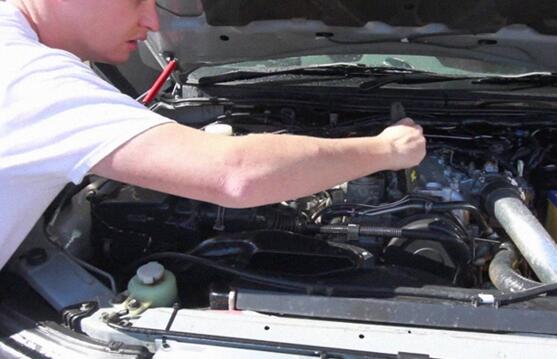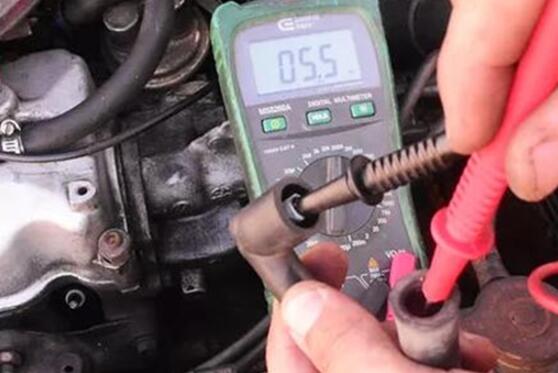 What are sympotoms of engine failures and how to diagnose ? Why does engine fail to start? What causes engine idled unsteadily? Why the engine shut off immediately after starting? High-tension lead, spark plug,ignition switch should also be tested in conventional ignition system. In this article, we will learn about it.
What are sympotoms of engine failures and how to diagnose ? Why does engine fail to start? What causes engine idled unsteadily? Why the engine shut off immediately after starting? High-tension lead, spark plug,ignition switch should also be tested in conventional ignition system. In this article, we will learn about it.
When engine have faults in conventional ignition system ,usually we should do as follows:
Visual Inspection
First, Check for loose high voltage wires and low-voltage circuit between the ignition coil and distributor. If so, restart the engine and see if it can be started after troubleshooting. If the\tvisual examination does not find any problem, proceed to the next troubleshooting step.

Pull out the central high-tension lead on the distributor, and make the high-tension lead terminal 5-8mm away from the engine block, then turn on the ignition switch, when start the engine with the starter, see whether to spark jump between the high-tension lead terminal and the engine block. There are three cases; The spark is strong; the spark is weak or the spark jumps.
A. If the spark is very strong, it indicates that the low-voltage circuit and
ignition coil is basically normal. While the fault is in the high-voltage circuit or spark plug, proceed to carry out the next step fault diagnosis.
B. If the spark is very weak, it may be caused by faulty components, such as breaker, capacitor and ignition coils, or poor connection of high-tension lead. Further diagnosis can be made in step (4).
C. If there is no spark, the possible causes of the fault include poor contact of the breaker, the movable contact point ground or short circuit of capacitor, short circuit or open circuit of the ignition coil, or poor contact of the ignition switch and ignition coil low-voltage circuit. Step 5 can be used for further troubleshooting.
High-tension lead test
Insert back into the central high-tension lead, pull out the high-tension lead on a cylinder spark plug for test, and make the high-tension lead terminal 5-8mm away from the engine block. If the spark does not jump or the spark is very weak, it indicates electric leakage or open circuit in distributor cap, rotor or high-tension lead, these parts need to be repaired. If the spark is still strong, the spark plug shall be removed for inspection. If the spark plugs of all cylinders are in good condition, then check the oil circuit, ignition timing and other possible faults that may cause the engine to fail to start.

When the breaker contact is open, turn on the ignition switch, and conduct jump spark test of the central high-tension lead by instantaneous ground between the "-" terminal of ignition coil (leaving quickly after wire the terminal is grounded), to see whether the spark at the terminal of the high-tension lead becomes stronger. If the spark becomes stronger, it is necessary to check the contact of the breaker, capacitor and other components; If the spark is still weak, check or replace the ignition coil.
Diagnose the cause of no spark jump with instantaneous short circuit method
When the breaker is disconnected, the ignition coil "-" and conduct jump spark test of the central high-tension lead by instantaneous ground between the ignition coil. If there is jump spark, it is necessary to check breaker contact, capacitor and other components. If the spark is still not jumping, then see if there is a spark when grounding at the moment. If not, check whether the low-voltage loop circuit of the ignition system is open circuit or the primary winding of the ignition coil is open circuit; If there is a spark when contacting. check whether the secondary winding of the ignition coil is open or short circuit fault, and whether central high-tension lead is open.
The sympotoms of engine failures
1.Engine idled unsteadily
The engine can start, but the engine runs unsteadily or even stops at idle speed. When accelerating, the exhaust pipe sounds like rur ..rur.. rur…Engine power is obviously insufficient.
This kind of fault phenomenon is generally due to individual cylinder not working or working bad, ignition timing is abnormal and other causes.

Check whether the cylinder spark jump
Pull out the high-tension lead of the cylinder and conduct the spark jump Spark jump test to see whether spark jump. If not, check distributor cap, high tension lead; If there is spark jump, check the spark plugs and repair or replace them if necessary.
2.The engine shut off immediately after starting
The engine starts smoothly, but as soon as you release the ignition switch (disconnect the ignition switch) the engine shuts down. The possible causes for this phenomenon include:
(1)The connection of the additional resistance of the ignition coil is broken or the additional resistance itself is burnt out (ignition coil with additional resistance).
(2)There is an open circuit between the ignition switch "I" terminal and the ignition coil "+" terminal.
(3)Poor ignition switch contact.
The fault diagnosis method is as follows:
Check the ignition switch
Turn on ignition switch. see if the charging indicator is on. If the charging indicator is not work, it indicates the contact point of the ignition switch is not in good condition, the ignition switch should be repaired or replaced. if the charging indicator is on, then proceed to the next step of fault diagnosis.
Check additional resistance
Check the resistance between ignition switch "+" "and two low voltage ignition coil terminals with multimeter. In breaker-point Ignition System, the additional resistance about 1.5 Ω. If the measured results are unavailable, it indicates that additional resistance have burn out and need to change the ignition coil. If additional resistance test is normal. You need to troubleshoot the circuit between the ignition switch and the ignition coil" + "terminal.
 James Smith
James Smith  July 08, 2020
July 08, 2020